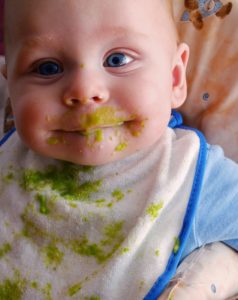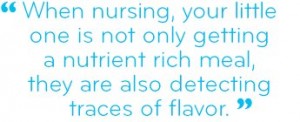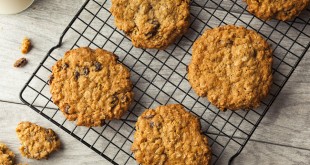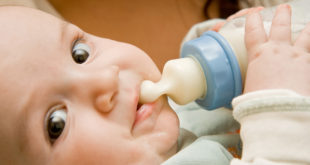| Getting Started | Good First Foods | Foods To Avoid |
|---|---|---|
|
(because babies can choke on them) |
||

The American Academy of Pediatrics (AAP) officially recommends that mothers breastfeed their babies exclusively for the first six months in order to “to support optimal growth and development”. “Optimal” means the very best, no matter how you look at it. Deciding what to feed your baby during the first six months to give him the best possible start in life is simple. He doesn’t need anything to eat besides breast milk. Dealing with the challenges presented by breastfeeding may not always be easy, but when it comes to what babies need to eat, it’s simple to know what’s best for them.
“Exclusively” means that you don’t need to give your baby anything besides breast milk for the first six months – no water, juice, formula, or cereal because he doesn’t need anything else. It will probably be very difficult to convince your mother-in-law of this, because formula fed babies do need extra things like water and iron that breastfed babies don’t. Formula just isn’t as complete a food for babies, but it’s hard for someone used to formula feeding to believe that a baby really doesn’t need anything else. I think that a lot of this goes back to the fact that you can’t really see or measure breast milk.
“Approximately” the first six months means that you have wiggle room here. Some babies are aren’t ready the day they turn six months, and may not be interested in solids until weeks, or months later. Very few, if any, babies actually ‘need’ solid foods before they are six months old, although they may be grabbing your spoon and the food off your plate earlier than that. There is no set time for babies to start eating solids, but if there is a family history of allergies, then the later you introduce other foods into his system, the better.
Formula fed babies may need solid foods earlier than breastfed babies because the iron in formula isn’t absorbed as well as the iron in human milk, so they are more likely to become anemic, and need iron enriched foods earlier. For breastfed babies, gradually introducing iron rich food into his diet in the second half of his first year, while continuing to breastfeed, is the best way to ensure that his diet is optimal, and that he gets the nutrients he needs.
The most important thing to remember is that breast milk is a nutrient dense food and should be the primary source of your baby’s nutrition throughout the entire first year of life while his body and brain are growing so rapidly. It is the ideal source of nourishment, and it’s composition changes to meet your growing babies needs. For example, the levels of antibodies in your milk increase as your baby starts solids and takes in less volume of milk, and the fat levels in the milk decrease as your baby slows down on his weight gain in the second six months of life. Gradual introduction of iron-enriched solid foods in the second half of the first year should complement the breast milk diet.
According to Ted Greiner, PhD, and noted breastfeeding researcher, any foods other than breast milk or formula given during the first 6 months have a displacement rather than additive effect because they displace the fat and calories the baby needs from milk.
From 6 – 12 months, babies need an “educational” diet, where other foods gradually begin to provide for nutritional needs that milk alone can’t provide. Breast milk or formula should be the main source (75%) of calories until the end of the first year.
From 12 – 24 months, the “complementary” diet goes up until at 18 months, milk provides 50% of the baby’s calories,
From 2 -3 years, up to 80% – 90% of the baby’s caloric intake is provided by foods other than milk.
Some formula companies recommend “Follow Up” formula for babies 4 months or older who are eating solid foods. These “Follow Up” formulas are, in my opinion, (and that of lots of doctors and infant nutritionists), not only not necessary, but very controversial. I think it’s another example of the formula industry trying to make more money by marketing a product that babies don’t need, by convincing moms that they do.
Remember the billions of dollars that the formula industry has to spend on advertising their product? They do that shamelessly, and profit nicely from it. For example: Mead Johnson (the company that makes Enfamil) recently stopped production of it’s Chocolate flavored Enfagrow Follow Up formula, after health care professionals criticized it for contributing to child obesity. Dr. Robert Lustig, a pediatric obesity expert, called it a “baby”milkshake”, and says “We have an epidemic of obesity in six months olds in this country”. Enough said about Follow Up formula, except that I want to personally thank Mead Johnson for thoughtfully mailing me free samples of Enfagrow that I didn’t ask for. I guess they figured out that I like babies or something. The packaging is so cute (a little box with cute little cartoons and slogans like “Mooove over milk”) that I’d almost be tempted to give it to my baby if I had one. Formula and baby food companies will go to great lengths to convince you to buy stuff that your baby really doesn’t need.
Foods like cereal and fruits also don’t provide the fat needed during the first year and beyond, so it is important to make breast milk the most prominent part of the baby’s diet while his body – and his brain – is still growing so quickly.
There is no need for extra vitamins, iron, fluoride, or any other supplements in the first six months as long as your baby is thriving on mother’s milk alone. The American Academy of Pediatrics (AAP) does not recommend fluoride supplements at all for babies less than six months old, whether they are breastfed or bottle-fed.
The exception to the vitamin rule is that doctors now recommend that all babies be supplemented with vitamin D because a very small percentage of babies don’t get enough vitamin D, and may, rarely, develop rickets a a result. The babies most at risk for vitamin D deficiency are those who are dark skinned, whose moms are vegetarians and don’t eat fish, meat, or dairy, and who don’t get much sun. They often live in inner city areas where they don’t get much outside exposure to sunlight, or they wear clothes that cover most of their body. It’s rare for babies to develop rickets, but because it does happen rarely, and because vitamin D supplementation seems to be harmless, it’s now routinely given to all babies, breast and bottle fed.
I recommend that nursing moms keep taking their prenatal vitamins while they’re breastfeeding, just as extra insurance to make sure their nutritional needs are met.
Breastfed infants rarely become anemic. Human milk contains less iron than formula, but the iron is much better absorbed (49% versus 10%). In addition, breastfed babies don’t lose iron due to occult intestinal bleeding the way formula fed babies do. Giving iron supplements to nursing babies can cause intestinal upset, due to special proteins in human milk which bind iron in the babies intestines and keep harmful bacteria from multiplying. Excess iron can interfere with the functioning of these proteins, allowing “bad” bacteria to thrive. The mom’s diet has nothing to do with the nursing baby’s iron levels, so taking iron won’t increase the iron in the baby’s system. If the nursing mom takes too much iron, she can make herself and the baby constipated.
If you are worried about your baby’s iron levels, ask your doctor to perform a simple hemoglobin test. Most doctors check this routinely at around nine months, but it can be done earlier if there is a reason for concern. A three month old infant will average a hemoglobin count of 12, but may range from 9.5 to 14.5. From six to twelve months, the average is also 12, with a range of 10.5 to 14.0.
Besides the fact that your baby doesn’t nutritionally need any other foods until at least the middle of his first year of life, there are some other good reasons for not rushing into introducing solid foods into his diet. Intestinal and developmental readiness varies widely from baby to baby.
A baby’s immature digestive tract isn’t prepared to handle a wide variety of foods until at least six months, when many digestive enzymes seem to click in. This is especially important if you have a family history of allergies. The protective protein IgA, which coats the baby’s intestines and prevents the passage of harmful allergens, doesn’t reach peak production until around seven months of age.
Gradual introduction of iron-enriched solid foods in the second half of the first year should complement the breast milk diet and ensure that your baby gets enough iron.
So, how do you tell when your baby is ready for his first taste of solids? Remember to look at your baby, not the calendar. At some point between 6 and 9 months, your baby will give you some signs that he might be ready for solid foods.
Here are some signs of readiness to look for:
- Can he sit up by himself? Sitting upright is necessary in order for him to properly swallow substances thicker than milk.
- Does he show signs of interest in what you’re eating? Watching food go into your mouth and grabbing food off your plate are definite signs of readiness. My daughter Ashley (now 32, and expecting her second baby), started solids at eight months, when she crawled up to the table, pulled herself up, grabbed a piece of toast crust off her brother’s plate, shoved it in her mouth, and proceeded to chew. Her brother was indignant, but I just figured, “Well, guess she’s ready for solids now.” Of course, she was my third child and I was a little more laid back by then. With my first child I dutifully started shoveling homemade earth mother food into him at four months. He was not impressed, especially when I fed him mixed turnips and yogurt. What can I say? He was my first baby, and I made my own baby food. We didn’t have Gerber First Foods back in 1976. Besides, he’s totally forgiven me by now.
- Is he able to pick up small objects? Most babies are totally into this by around six month, and it indicates that they can finger feed and actually get some of the food into their mouths.
- If you offer him a small taste of food, can he swallow it, or does he push it back out with his tongue? The tongue-thrusting reflex is a protective device that begins to diminish at around six months of age. When babies are really ready for solids, the muscles in their mouth and tongue are developed enough to transfer food from their tongue to the back of their mouth. This action has to be coordinated with swallowing, and most babies younger than six months are just not ready. Have you ever tried to feed a tiny baby solid foods? In our mother-in-law’s generation, babies were put on cereal at around six weeks. Mothers put food in the baby’s mouth, he spit it out, they scraped it back up, put it in his mouth again, he spit it out again, and so it went. (Piece of trivia: Did you know that it’s impossible to spoon feed a baby and not make little movements with your tongue? Try it sometime). And by the way, don’t let anyone tell you that if you feed your baby solids he will sleep through the night. Studies have shown that it just doesn’t work that way. I have known breastfed babies who were sleeping through the night at two weeks, and formula fed babies who were still waking up at two years. Every baby’s sleep patterns differ. Believe me, if getting a baby to sleep for eight hours was as simple as stuffing him full of cereal at bedtime, there wouldn’t be so many books on the market on how to get your baby to sleep through the night.
- Is your baby teething? Teeth usually don’t appear until he is six or seven months old, which is evidence that the tiny infant is designed primarily to suck rather than to chew. The increased salivation that accompanies teething can also aid indigestion. I have had two babies out of six who got their first teeth at four months, however, so the appearance of teeth is only one indicator of readiness for solids.
- In the beginning, your goal is not to fill up your baby’s stomach. This is a learning experience for both of you, so begin with a tiny amount and see how he reacts. Your goal is to expose him to new tastes and textures, not to substitute an inferior food (cereal, for example) for a superior food (breast milk). Remember that if he is ravenously hungry, he won’t be in the mood to try anything new. Offer solids after nursing, kind of like dessert. Usually the best times are in the mid-morning or mid-afternoon. Follow your baby’s lead and gradually increase the amounts offered.
- If you want to be really conservative (especially recommended if you have a family history of allergies), then introduce new foods one at a time, allowing a week before introducing a new food. The older the baby, the less important this is, because he has developed more defenses against allergens. If a particular food seems to cause a reaction (runny nose, rash on the face or bottom, or fussiness and gas), eliminate that food for a week, then try it again. If he has the same reaction two or three times, discontinue it for at least six months.
- You may want to use a blender or baby food grinder in the beginning. If you wait until at least six months, there is no need to spend money on the Stage One, First Foods, etc. that the baby food companies spend so much money to convince you is necessary. It’s easy to use a fork to mash and moisten the food you serve the rest of the family. Of course, you want to separate the baby’s food before you add salt and spices. Commercial baby foods are nice for when you are traveling – if you are eating in a Mexican restaurant, for example, you will probably want to feed him strained sweet potatoes rather than a spicy burrito.
- Be prepared for a huge mess. This may seem rather obvious, but what a lot of mothers don’t think about is the fact that once you start solids, you are dealing not only with wiping a messy face with green beans encrusted into your baby’s hair, but you also deal with the fact that his bowel movements will never be the same. Remember how newborn’s stools don’t smell foul, but have a distinctive kind of yeasty odor? Those days are over the first time your baby has a bite of solid foods. Of course, seeing how much fun he has finger feeding himself a high chair tray full of mashed banana (some will actually go in his mouth) is worth just about anything. That’s another advantage to waiting to introduce solids – you can pretty much dispense with the whole spoon feeding thing and let him finger feed himself, once he can sit up and pick up small objects. It’s much easier for you (although admittedly messier) and a lot more fun for your baby, too. (Important tip: Bananas stain worse than just about every food you give babies. It morphs into a nasty black stain that’s almost impossible to get out of clothes or carpet. I figured this out the hard way with my first baby. )
Here are some good first foods:
- Bananas
- Pears
- Applesauce
- Squash
- Carrots
- Sweet Potatoes
- Avocados
- Peaches
- Rice or Barley cereals (notice that cereal is last on the list. This is because cereal is highly processed, and would provide only empty calories if not enriched with iron and vitamins. Cereal has traditionally been considered a first food for babies, but only because formula fed babies need the extra iron that breastfed babies don’t.
- After introducing the foods listed above, you can move on to meats (mix them with something on the list above that he is already familiar with if he doesn’t seem to like it at first). Tofu is a nutritious food, and can be easily cut into soft, bite-size cubes (especially good if you are a vegetarian). Fish is an excellent source of protein, but watch out for bones.
- Whole grain pieces of bread, without added egg, milk, or sugar are also good first foods.
- Avoid cow’s milk or dairy products, especially if there is a family history of allergies. Most babies can tolerate yogurt and natural cheeses after they are nine or ten months old. If there is a family history of allergies, hold off until the baby is at least a year old.
- Offer supplemental fluids (water and juice) sparingly. Breastfed babies don’t need extra water, since breast milk provides all the water they need. If an infant ingests too much water, it can actually cause a form of “water intoxication” which can cause the sodium in the blood to become diluted so the body can’t function properly. Fruit juice contains many empty calories, and is less nutritious than the fruit itself because it doesn’t contain the nutritious pulp. Studies have shown that drinking excessive amounts of fruit juice can contribute to childhood obesity (as can “Follow-up Formulas” – especially the chocolate-flavored ones). At some point between six and nine months, many babies show an interest in drinking from a cup. Offer a little water or breast milk (cow’s milk should be avoided until he is twelve months old), and occasionally give him some juice to drink (dilute it with water in the beginning).
Foods To Avoid, or eat in moderation:
- Salt (added salt can stress your baby’s immature kidneys)
- Chemical additives. No one is sure about their effects on adults, much less infants.
- Caffeine – a stimulant, not a food. It excessive doses, it can elevate his blood sugar and stimulate his heart and lungs in detrimental ways.
- Sugar – empty calories with almost no nutritive value. Why let your baby develop a taste for something linked with tooth decay, heart disease, diabetes obesity, and behavior problems?
- Chocolate – almost always contains sugar and caffeine, and can also be an allergen. Not recommended for children under two, and sparingly after that.
- Common Allergens – cow’s milk, wheat, corn, and egg whites – the best thing to do is hold off for the first year and then experiment, especially if there is a family history of allergies.
Foods To DEFINITELY Avoid (because babies can choke on them):
- Grapes
- Popcorn
- Hot dogs or chunks of meat
- Dry cereal
- Apple chunks or slices
- Potato chips, Cheetos, etc.
- Raw carrot sticks or slices
- Berries (whole or unseeded)
- Cookies
- Hard candy
- Peanut butter
- Whole nuts or seeds
There is more and more research showing that breastfed babies are exposed to a variety of tastes, since the mom’s milk is slightly flavored by the food she eats. This exposure makes breastfed babies more likely to like a broader range of foods, and less likely to become picky eaters.
Because babies feeding skills, appetites, and readiness for solids are as unique as their temperaments, Individual abilities and tastes should dictate how, when, and what we feed them. Breast milk is the perfect food for the first year of life and beyond, so just enjoy feeding your baby and don’t worry about whether he finishes the whole jar of strained spinach. When you are nursing your baby, you have your nutritional bases covered. Relax, and follow your heart and your baby’s lead. As long as he is happy, healthy, and growing, you know that you are doing the right thing.
For more information about starting solids, check out the Baby Led Weaning for Beginners and Beyond group on Facebook.
Anne Smith, IBCLC
Breastfeeding Basics
* Please ‘Pay it Forward’!*
If you found this article helpful, please consider making a small donation to my favorite cause – Project Pets: Spay, Neuter, Love – an all volunteer, non-profit organization that provides free spay and neuter services for homeless rescue dogs and cats…because every baby deserves a home, whether they have two legs or four! To find our more, visit Project Pets on Facebook.
When should I start giving my nursing baby solid foods?
The American Academy of Pediatrics (AAP) officially recommends that mothers breastfeed their babies exclusively for the first six months in order to support optimal growth and development. “Exclusively” means that you don’t need to give your baby anything besides breast milk for the first six months – no water, juice, formula, or cereal.
 Breastfeeding Basics
Breastfeeding Basics







